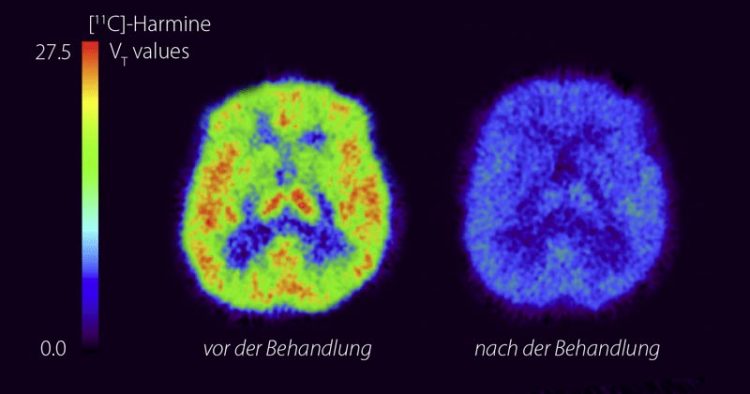Monoamine oxidase A: biomarker for postpartum depression

Positron-Emission-Tomography (PET) of a depressive patient without medication (left) with elevated monoamine-oxidase-A-levels (green, yellow, red) and after a six-week-treatment with the monoamine-oxidase-A-inhibitor moclobemid (right). © Sacher et al., 2011, J Psy Neurosci.
Many women suffer from baby blues after giving birth. Some even develop full-blown postpartum depression in the weeks that follow. Monoamine oxidase A, an enzyme responsible for the breakdown of neurotransmitters like dopamine and serotonin, plays an important role in this condition.
In comparison to healthy women, women who experience postpartum depression present strongly elevated levels of the enzyme in their brains. This was discovered by a Canadian-German research team including Julia Sacher from the Max Planck Institute for Human Cognitive and Brain Sciences in Leipzig. Their findings could help in the prevention of postpartum depression and in the development of new drugs for its treatment.
For most women, the birth of their baby is one of the most strenuous but also happiest days in their lives. However, joy and happiness are often followed by fatigue and exhaustion. The vast majority of women experience a temporary drop in mood for a few days after birth.
These symptoms of “baby blues” are not an illness; however, in some cases they can represent early signs of an imminent episode of depression: in 13 percent of mothers, the emotional turmoil experienced after childbirth leads to the development of a full-blown postpartum depression. Postpartum depression is harmful not only to the mother, but also to the baby. It is difficult to treat this condition effectively, as its precise neurobiological causes have remained unidentified to date.
The new study shows that postpartum depression is accompanied by strongly elevated monoamine oxidase A in the brain, particularly in the prefrontal cortex and in the anterior cingulate cortex. In women with postpartum depression, the values recorded were 21 percent higher than those of women who were not plagued by negative feelings after giving birth. Women who did not develop full-blown depression but found themselves crying more often than usual due to depressed mood also presented moderately elevated values.
“Therefore, we should promote strategies that help to reduce monoamine oxidase A levels in the brain, and avoid everything that makes these values rise,” explains Sacher. Such factors include heavy smoking, alcohol consumption and chronic stress, for example when the mother feels neglected and abandoned by her partner and family. “My ultimate goal is to provide women and their families with very concrete lifestyle recommendations that will enable them to prevent postpartum depression,” explains the psychiatrist.
A new generation of long-established drugs could also play an important role in the treatment of postpartum depression in future. Up to now, depressed mothers are mainly given drugs that increase the concentration of serotonin in the brain. However, because monoamine oxidase A breaks down not only serotonin but also other monoamines like dopamine and noradrenaline, a treatment that directly targets monoamine oxidase A could have a higher success rate, particularly in very serious cases: this alternative is provided by selective and reversible monoamine-oxidase- A inhibitors.
“The first monoamine oxidase inhibitors often had severe side effects, for example hypertensive crises, which necessitated adherence to a strict diet,” explains Sacher. “However, the new selective and reversible drugs are better tolerated,” she adds. In the next stage of this research involving clinical trials, the scientists intend to test the effectiveness of these reversible monoamine oxidase A inhibitors in the treatment of postpartum depression.
Because the measurement of this enzyme in the brain requires complex technology, it is not suitable for routine testing. Thus, the researchers are also looking for a peripheral marker of this enzyme that can be detected in saliva or blood.
Four years ago, Julia Sacher and her colleagues at the Centre for Addiction and Mental Health CAMH in Toronto already succeeded in showing that, in the first week postpartum, the concentration of the enzyme monoamine oxidase A in the brain is on average 40 percent higher than in women who had not recently given birth. “The monoamine oxidase A values behave in the opposite way to oestrogen levels. When oestrogen levels drop acutely after childbirth, the concentration of monoamine oxidase A rises. This drastic change also influences serotonin levels, known as the happiness hormone,” explains Dr. Sacher. In most women, the values quickly return to normal. In others, they remain raised – and thereby promote the development of depression.
Contact
Dr. Julia Sacher
Max Planck Institute for Human Cognitive and Brain Sciences, Leipzig
Phone: +49 341 9940-2409
Media Contact
More Information:
http://www.mpg.de/8331073/postpartum-depression_monoamine-oxidase-aAll latest news from the category: Health and Medicine
This subject area encompasses research and studies in the field of human medicine.
Among the wide-ranging list of topics covered here are anesthesiology, anatomy, surgery, human genetics, hygiene and environmental medicine, internal medicine, neurology, pharmacology, physiology, urology and dental medicine.
Newest articles

Red light therapy for repairing spinal cord injury passes milestone
Patients with spinal cord injury (SCI) could benefit from a future treatment to repair nerve connections using red and near-infrared light. The method, invented by scientists at the University of…

Insect research is revolutionized by technology
New technologies can revolutionise insect research and environmental monitoring. By using DNA, images, sounds and flight patterns analysed by AI, it’s possible to gain new insights into the world of…

X-ray satellite XMM-newton sees ‘space clover’ in a new light
Astronomers have discovered enormous circular radio features of unknown origin around some galaxies. Now, new observations of one dubbed the Cloverleaf suggest it was created by clashing groups of galaxies….





















